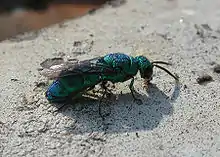Cuckoo wasp
Commonly known as cuckoo wasps or emerald wasps, the hymenopteran family Chrysididae is a very large cosmopolitan group (over 3000 described species) of parasitoid or kleptoparasitic wasps, often highly sculptured,[1] with brilliant metallic colors created by structural coloration.[2] They are most diverse in desert regions of the world, as they are typically associated with solitary bee and wasp species, which are also most diverse in such areas. Their brood parasitic lifestyle has led to the evolution of fascinating adaptations, including chemical mimicry of host odours by some species.[3]
| Cuckoo wasps | |
|---|---|
 | |
| Scientific classification | |
| Kingdom: | Animalia |
| Phylum: | Arthropoda |
| Class: | Insecta |
| Order: | Hymenoptera |
| Superfamily: | Chrysidoidea |
| Family: | Chrysididae Latreille, 1802 |
| Subfamilies | |
|
Amiseginae | |
Nomenclature

The term "cuckoo wasp" refers to the cuckoo-like way in which wasps in the family lay eggs in the nests of unrelated host species.[1]
Chrysididae, the scientific name of the family, refers to their shiny bodies and is derived from Greek chrysis, chrysid-, "gold vessel, gold-embroidered dress", plus the familial suffix -idae. The common names of many species pay similar tribute to their appearance: jewel wasp, gold wasp, emerald wasp, ruby wasp and so on (cf. French guêpe de feu, "fire-wasp", and German / Dutch Goldwespe / goudwesp, "gold-wasp").[4]
Ecology and behavior

Members of the largest subfamily, Chrysidinae, are the most familiar; they are generally kleptoparasites, laying their eggs in host nests, where their larvae consume the host egg or larva while it is still young, then the food provided by the host for its own juvenile. Chrysidines are distinguished from the members of other subfamilies in that most have flattened or concave lower abdomens and can curl into a defensive ball when attacked by a potential host, in the manner of a pill bug.[1] Members of the other subfamilies are parasitoids, of either sawflies or walking sticks, cannot fold up into a ball.
Chrysidids are always solitary. They fly mainly in the hottest and driest months of summer, preferring subtropical and Mediterranean climates. They favor dry areas and sandy soils; each species is confined to a narrow type of microhabitat where adults may rest or find hosts to parasitize, for example on bare soil or on dead wood where other solitary wasps have their nest holes. Some species visit flowers such as of the Umbelliferae, Compositae and Euphorbiae.[4]
Evolution
The fossil record of the group is fragmentary, the oldest fossil known being from the lower Aptian Turga Formation of Russia.[5] Other Cretaceous specimens are known from the Albian-Cenomanian amber of France,[6] a Cenomanian limestone in Morocco.[7] The upper Santonian Taimyr amber of Russia[8] and the upper Campanian Canadian amber.[9]
References
- Agnoli, Gian Luca; Rosa, Paolo (20 September 2013). "Chrysidid generalities". Chrysis.net. Retrieved 9 March 2015.
- Agnoli, Gian Luca; Rosa, Paolo (20 September 2013). "Chrysidid coloration". Chrysis.net. Archived from the original on 28 December 2017. Retrieved 16 June 2015.
- Pauli, Thomas; Castillo‐Cajas, Ruth (25 August 2018). "Phylogenetic analysis of cuckoo wasps (Hymenoptera: Chrysididae) reveals a partially artificial classification at the genus level and a species‐rich clade of bee parasitoids". Systematic Entomology. 44 (2): 322–335. doi:10.1111/syen.12323.
- Agnoli, Gian Luca; Rosa, Paolo (17 March 2013). "Chrysidids: Family overview". Chrysis.net. Retrieved 9 March 2015.
- A. P. Rasnitsyn. 1990. Pozdne-Mezozoyskie Nasekomye Vostochnogo Zabaykal'ya. Akademiya Nauk SSSR, Trudy Paleontologicheskogo Instituta 239:177-205
- Cockx, Pierre F.D.; McKellar, Ryan C.; Perrichot, Vincent (December 2016). "First records of the subfamilies Bethylinae (Hymenoptera: Bethylidae) and Cleptinae (Hymenoptera: Chrysididae) in Upper Cretaceous amber from France" (PDF). Cretaceous Research. 68: 1–8. doi:10.1016/j.cretres.2016.07.008.
- Martill, David M.; Ibrahim, Nizar; Brito, Paulo M.; Baider, Lahssen; Zhouri, Samir; Loveridge, Robert; Naish, Darren; Hing, Richard (August 2011). "A new Plattenkalk Konservat Lagerstätte in the Upper Cretaceous of Gara Sbaa, south-eastern Morocco". Cretaceous Research. 32 (4): 433–446. doi:10.1016/j.cretres.2011.01.005. ISSN 0195-6671.
- H. E. Evans. 1973. Cretaceous aculeate wasps from Taimyr, Siberia (Hymenoptera). Psyche 80:166-178
- H. E. Evans. 1969. Three new Cretaceous aculeate wasps (Hymenoptera). Psyche 76:251-261
External links
| Wikimedia Commons has media related to Chrysididae. |
- Western Australian Museum - Cuckoo Wasp factsheet
- Chrysis. net a picture rich and very informative site
- Family Chrysididae - Cuckoo Wasps at Bugguide, images and information.
- Chrysididae Identification Guide An online guide to the Chrysidids of Eastern North America
- Hymis de Images (=Bilder)